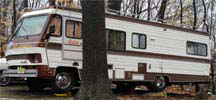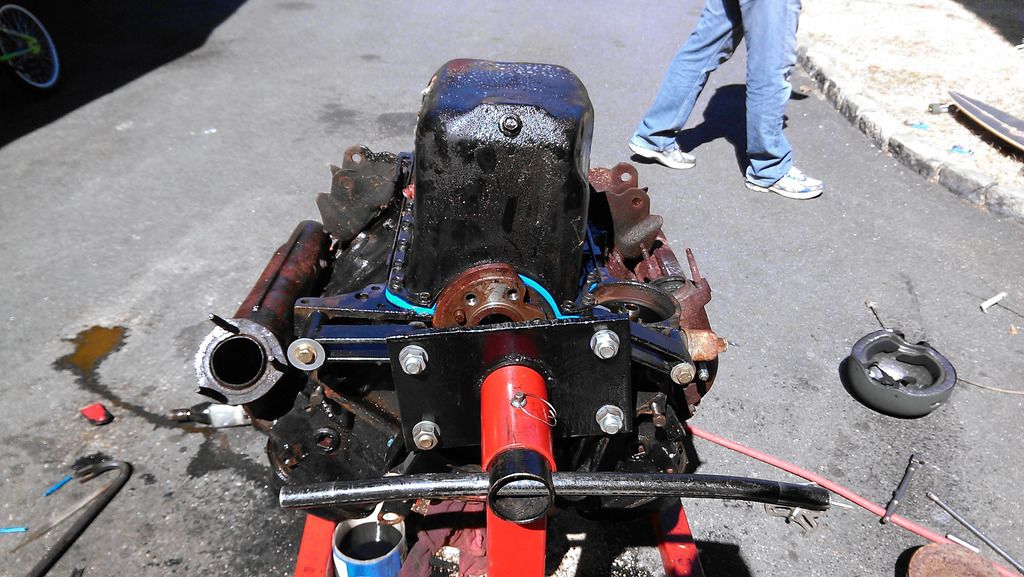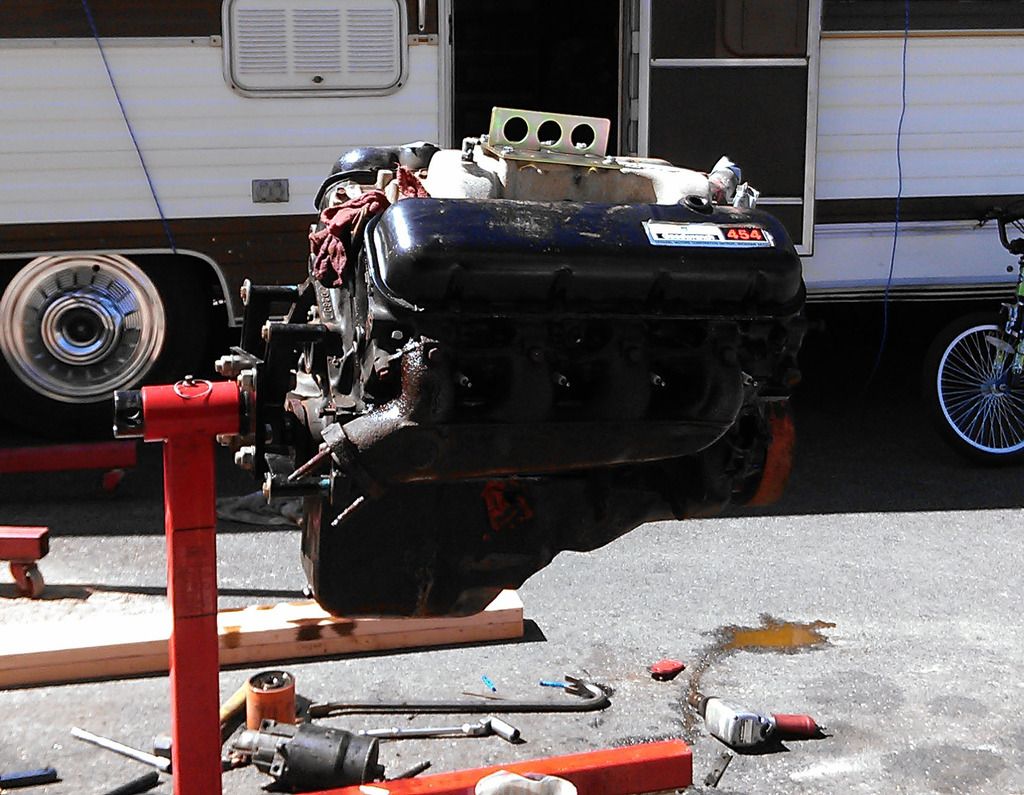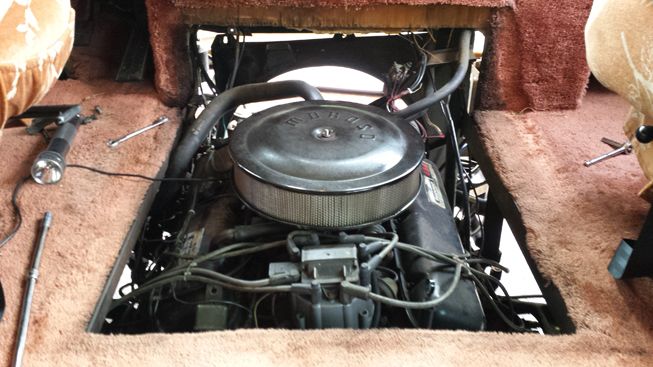- Good Sam Community
- Groups
- Motorhome Group
- Forum
- Cleaning out a cast iron block
- Subscribe to RSS Feed
- Mark Topic as New
- Mark Topic as Read
- Float this Topic for Current User
- Bookmark
- Subscribe
- Mute
- Printer Friendly Page
Cleaning out a cast iron block
- Mark as New
- Bookmark
- Subscribe
- Mute
- Subscribe to RSS Feed
- Permalink
- Report Inappropriate Content
Aug-31-2015 04:15 PM
With the water pump off of it I ran water through it until it came out clean. Last year was the first camping season with it. It ran great, though on the warm side.
This year, on my last trip out, it overheated pretty bad. I could not get it to cool down.
Yanked the radiator and brought it to a local shop to be rebuilt. For a significant sum of money, I'm getting an all-new radiator custom built. The rad shop called me today and said my problem was that there was a baseball-sized chunk of rust clogging the inlet side of the radiator. The radiator was toast anyway, but they advised me to figure out why this happened otherwise the new radiator will meet the same fate.
So - I need to clean the block out some how. On the one hand I'd like to think the many heat cycles have dislodged most of the rust in there. Upon removing the radiator the lower hose drained clean. I took the thermostat housing off and hosed out the engine - came out clean too. But how can I be sure?
The radiator guy suggested yanking out the drain plugs and seeing whats in there. He suggested pulling out the freeze plugs too.
So....does anyone have any advice that's different than this? Ideas would be appreciated.

- Labels:
-
Class A
- Mark as New
- Bookmark
- Subscribe
- Mute
- Subscribe to RSS Feed
- Permalink
- Report Inappropriate Content
Sep-02-2015 05:27 PM
- Mark as New
- Bookmark
- Subscribe
- Mute
- Subscribe to RSS Feed
- Permalink
- Report Inappropriate Content
Sep-01-2015 12:19 PM
As mowermech implied, if I had the time and money to "do it right", I would have :). Naturally I wanted something reliable, but not break the bank (the motorhome cost me $200). The engine was allegedly low-mileage, and an internal inspection verified this. I purposely got something that wouldn't (or shouldn't) need rebuilt. The rust in the block was a bit of a curve ball. Now that I've paid almost as much for a new radiator as the engine itself, I need to take some extra measures.
I'd like to think that it's cleaned itself out and deposited all the rust in the old radiator. Based on all the conversation here I think I'll pull the drain plugs and rinse it out to see what happens. If it's clogged up (won't drain, or ugliness comes out) then I'll run something like Evapo-Rust through it.

- Mark as New
- Bookmark
- Subscribe
- Mute
- Subscribe to RSS Feed
- Permalink
- Report Inappropriate Content
Sep-01-2015 10:22 AM
While removing the engine and knocking out the freeze plugs is probably the best idea, it is also the most amount of time and effort.
I'd put some sort of flush chemical in the system then take it to a shop to have it reversed flushed.
Then I'd keep an eye on the temps while running and any change in color of the coolant.
Sometimes easy/cheap solutions can last a lifetime.
- Mark as New
- Bookmark
- Subscribe
- Mute
- Subscribe to RSS Feed
- Permalink
- Report Inappropriate Content
Sep-01-2015 06:35 AM
Then replace the cam bearings (the hot tank chemicals will eat them), install new plugs, hone the cylinders, and reassemble it with new rings and bearings.
while you are at it, might as well strip the heads down and soak them, too, then do a three angle valve job.
Since you probably don't want to do that (I wouldn't), get the best, strongest, cooling system cleaner you can find, and follow the instructions to the letter. The stuff will probably be caustic, so following the instructions is a MUST DO!
Good luck.
2017 Jayco TT
Daily Driver: '14 Subaru Outback
1998 Dodge QC LWB, Cummins, 5 speed, 4X2
2 Kawasaki Brute Force 750 ATVs.
Pride Raptor 3 wheeled off-road capable mobility scooter
"When seconds count, help is only minutes away!"
- Mark as New
- Bookmark
- Subscribe
- Mute
- Subscribe to RSS Feed
- Permalink
- Report Inappropriate Content
Sep-01-2015 06:17 AM
- Mark as New
- Bookmark
- Subscribe
- Mute
- Subscribe to RSS Feed
- Permalink
- Report Inappropriate Content
Sep-01-2015 05:22 AM
Check it out.
2000 Jeep Wrangler
- Mark as New
- Bookmark
- Subscribe
- Mute
- Subscribe to RSS Feed
- Permalink
- Report Inappropriate Content
Aug-31-2015 07:39 PM
dodge guy wrote:
I'de pull the most accessible freeze plugs. You'de be surprised what can hide at the bottom of a block! When I had my Dodge conv. van with the 5.9 I had a freeze plug start to leak (rusting from the inside out). I pulled all the plugs and flushed the block from the front to back and back to front. Installed the new freeze plugs and fresh coolant. That alone dropped the coolant temp about 15 degrees. After that I installed a new radiator and fan clutch and it again dropped a bit more. The engine always ran about 210 when I got it. After all that even when towing it took a lot to get it to break 200 deg.
Thanks. I turned it upside down for a few days to try to get the junk to move out.

Rusting from the inside out is a pretty good indication that there's junk stuck in there.

- Mark as New
- Bookmark
- Subscribe
- Mute
- Subscribe to RSS Feed
- Permalink
- Report Inappropriate Content
Aug-31-2015 07:30 PM
FIRE UP wrote:
Turbo,
Just a word here. While water pumps do a fair job of moving water/coolant throughout the engine, they do have a hard time "removing" debris/sand/large scale deposits/etc. that is lodged down in the water jackets and cylinders and block walls, way down low in the water jackets. I proved that many-a-time when I had the blocks out and on a stand, and even in some chassis that I did "in-chassis" rebuilds.
Now, again, that was way back then. I have no idea on how well the later engines are prepped for assembly these days. You're replacement is close the year/models I worked with . And, it did not matter what maker. I had the same results from tear-downs on Ford, Chevy, Dodge, AMC, Ford Courier, and more. Good luck on your venture.
Scott
It's one of the last Mark IV big blocks manufactured with a 1990 date stamp. I'll see what I can do to get it cleaned out as much as possible. I'm hoping I don't find anything significant when I pull the drain plugs. Yeah, I should have done that while it was on the stand in the driveway (note the rusty puddle):

But it's in there now - waiting for that radiator!


- Mark as New
- Bookmark
- Subscribe
- Mute
- Subscribe to RSS Feed
- Permalink
- Report Inappropriate Content
Aug-31-2015 07:30 PM
Son Brandon 17yrs
Daughter Marissa 16yrs
Dog Bailey
12 Forest River Georgetown 350TS Hellwig sway bars, BlueOx TrueCenter stabilizer
13 Ford Explorer Roadmaster Stowmaster 5000, VIP Tow>
A bad day camping is
better than a good day at work!
- Mark as New
- Bookmark
- Subscribe
- Mute
- Subscribe to RSS Feed
- Permalink
- Report Inappropriate Content
Aug-31-2015 07:05 PM
turbojimmy wrote:FIRE UP wrote:
TurboJimmy,
Long, long ago in a far away place, (Star Wars stuff, remember?) I used to rebuild engines for side job. When I pulled them and put them on stand to perform surgery on them, I'd take them all the way down to a gain as much access to any portion of the block I could get my little hands on.
Every single time, I'd pull every freeze plug and drain plug. You'd be surprised on how much SAND I'd find in there, big chunks of black carbon, solid chunks of pure rust etc. I'd have to pry much of it out and or, use a chisel and break much of it up to be able to remove it through the freeze plug holes. Once all the debris, sand and other big stuff was removed, then I'd hit with special, long nosed nozzle that I had for my garden hose. You'd still be surprised at what came out as a result of using that nozzle.
That was then, (from about '65 to, oh around '90 is when I quit that non-sense) and this is now. Unless it's an old hot rod, i.e. '60s Chevy etc., I won't even think about pulling an engine in a motor home. But, back to your issue. Yep, pulling the freeze plugs is the least you can do to get the closest inspection at the cheapest cost. Freeze plugs are cheap.
If you have one or, have access to one, you can use an "Inspection camera" to get into many tight places, inside the water jackets of that block. You know, the kind that Home Depot, Lowes, and other tool places sell. I got mine from Costco quite a while back and, it's not the best but, it sure works for getting into very tight places and seeing what's in there. Good luck.
Scott
Thanks! I'll start with the drain plugs, assuming I can free them up. If it looks bad, I'll start pulling freeze plugs. I'm hoping that the problem was the clogged radiator and not clogged coolant passages - maybe the gunk made its way through the block and accumulated at the radiator inlet. The rad shop told me that the stock high efficiency radiator is made of many smaller tubes rather than some smaller amount of larger tubes. Smaller tubes clog easier. Dunno.
Yanking the engine out isn't really that bad. On the '84 there's not a lot to unhook. The 454 comes out the door easily without the exhaust manifolds on it. Everything is easy to get at. Not that I want to do it again, but far better than replacing the TCC solenoid on a FWD Northstar Cadillac, for example (top of the list of things I will never do again).
Turbo,
Just a word here. While water pumps do a fair job of moving water/coolant throughout the engine, they do have a hard time "removing" debris/sand/large scale deposits/etc. that is lodged down in the water jackets and cylinders and block walls, way down low in the water jackets. I proved that many-a-time when I had the blocks out and on a stand, and even in some chassis that I did "in-chassis" rebuilds.
Now, again, that was way back then. I have no idea on how well the later engines are prepped for assembly these days. You're replacement is close the year/models I worked with . And, it did not matter what maker. I had the same results from tear-downs on Ford, Chevy, Dodge, AMC, Ford Courier, and more. Good luck on your venture.
Scott
SDFD RETIRED
2004 Itasca Horizon, 36GD Slate Blue 330 CAT
2011 GMC Sierra 1500 Ext Cab 4x4 Toad
2008 Caliente Red LVL II GL 1800 Goldwing
KI60ND
- Mark as New
- Bookmark
- Subscribe
- Mute
- Subscribe to RSS Feed
- Permalink
- Report Inappropriate Content
Aug-31-2015 07:00 PM
Big Katuna wrote:
You can add a coolant filter too.. Change it often until it's clean.
I'm showing my ignorance. Does someone make a coolant filter for the 454?
Or, do you adapt a filter for a diesel to the gas 454?
- Mark as New
- Bookmark
- Subscribe
- Mute
- Subscribe to RSS Feed
- Permalink
- Report Inappropriate Content
Aug-31-2015 06:14 PM
Big Katuna wrote:
You can add a coolant filter too.. Change it often until it's clean.
X2
- Mark as New
- Bookmark
- Subscribe
- Mute
- Subscribe to RSS Feed
- Permalink
- Report Inappropriate Content
Aug-31-2015 06:01 PM
FIRE UP wrote:
TurboJimmy,
Long, long ago in a far away place, (Star Wars stuff, remember?) I used to rebuild engines for side job. When I pulled them and put them on stand to perform surgery on them, I'd take them all the way down to a gain as much access to any portion of the block I could get my little hands on.
Every single time, I'd pull every freeze plug and drain plug. You'd be surprised on how much SAND I'd find in there, big chunks of black carbon, solid chunks of pure rust etc. I'd have to pry much of it out and or, use a chisel and break much of it up to be able to remove it through the freeze plug holes. Once all the debris, sand and other big stuff was removed, then I'd hit with special, long nosed nozzle that I had for my garden hose. You'd still be surprised at what came out as a result of using that nozzle.
That was then, (from about '65 to, oh around '90 is when I quit that non-sense) and this is now. Unless it's an old hot rod, i.e. '60s Chevy etc., I won't even think about pulling an engine in a motor home. But, back to your issue. Yep, pulling the freeze plugs is the least you can do to get the closest inspection at the cheapest cost. Freeze plugs are cheap.
If you have one or, have access to one, you can use an "Inspection camera" to get into many tight places, inside the water jackets of that block. You know, the kind that Home Depot, Lowes, and other tool places sell. I got mine from Costco quite a while back and, it's not the best but, it sure works for getting into very tight places and seeing what's in there. Good luck.
Scott
Thanks! I'll start with the drain plugs, assuming I can free them up. If it looks bad, I'll start pulling freeze plugs. I'm hoping that the problem was the clogged radiator and not clogged coolant passages - maybe the gunk made its way through the block and accumulated at the radiator inlet. The rad shop told me that the stock high efficiency radiator is made of many smaller tubes rather than some smaller amount of larger tubes. Smaller tubes clog easier. Dunno.
Yanking the engine out isn't really that bad. On the '84 there's not a lot to unhook. The 454 comes out the door easily without the exhaust manifolds on it. Everything is easy to get at. Not that I want to do it again, but far better than replacing the TCC solenoid on a FWD Northstar Cadillac, for example (top of the list of things I will never do again).

- Mark as New
- Bookmark
- Subscribe
- Mute
- Subscribe to RSS Feed
- Permalink
- Report Inappropriate Content
Aug-31-2015 05:44 PM
turbojimmy wrote:
This is my second season with my '84 Allegro. Bought it with a blown engine. Put a Craigslist-found 454 in it (truck spec GM Performance crate engine). When I got the engine home, put it on a stand and turned it upside down a bunch of rusty water came out of it. An alarming amount actually.
With the water pump off of it I ran water through it until it came out clean. Last year was the first camping season with it. It ran great, though on the warm side.
This year, on my last trip out, it overheated pretty bad. I could not get it to cool down.
Yanked the radiator and brought it to a local shop to be rebuilt. For a significant sum of money, I'm getting an all-new radiator custom built. The rad shop called me today and said my problem was that there was a baseball-sized chunk of rust clogging the inlet side of the radiator. The radiator was toast anyway, but they advised me to figure out why this happened otherwise the new radiator will meet the same fate.
So - I need to clean the block out some how. On the one hand I'd like to think the many heat cycles have dislodged most of the rust in there. Upon removing the radiator the lower hose drained clean. I took the thermostat housing off and hosed out the engine - came out clean too. But how can I be sure?
The radiator guy suggested yanking out the drain plugs and seeing whats in there. He suggested pulling out the freeze plugs too.
So....does anyone have any advice that's different than this? Ideas would be appreciated.
TurboJimmy,
Long, long ago in a far away place, (Star Wars stuff, remember?) I used to rebuild engines for side job. When I pulled them and put them on stand to perform surgery on them, I'd take them all the way down to a gain as much access to any portion of the block I could get my little hands on.
Every single time, I'd pull every freeze plug and drain plug. You'd be surprised on how much SAND I'd find in there, big chunks of black carbon, solid chunks of pure rust etc. I'd have to pry much of it out and or, use a chisel and break much of it up to be able to remove it through the freeze plug holes. Once all the debris, sand and other big stuff was removed, then I'd hit with special, long nosed nozzle that I had for my garden hose. You'd still be surprised at what came out as a result of using that nozzle.
That was then, (from about '65 to, oh around '90 is when I quit that non-sense) and this is now. Unless it's an old hot rod, i.e. '60s Chevy etc., I won't even think about pulling an engine in a motor home. But, back to your issue. Yep, pulling the freeze plugs is the least you can do to get the closest inspection at the cheapest cost. Freeze plugs are cheap.
If you have one or, have access to one, you can use an "Inspection camera" to get into many tight places, inside the water jackets of that block. You know, the kind that Home Depot, Lowes, and other tool places sell. I got mine from Costco quite a while back and, it's not the best but, it sure works for getting into very tight places and seeing what's in there. Good luck.
Scott
SDFD RETIRED
2004 Itasca Horizon, 36GD Slate Blue 330 CAT
2011 GMC Sierra 1500 Ext Cab 4x4 Toad
2008 Caliente Red LVL II GL 1800 Goldwing
KI60ND





